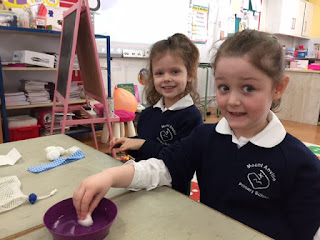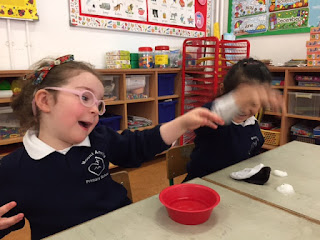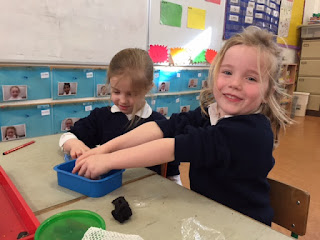We explored lots of different fabrics using a "feely
bag" which included everything from plastic swimming caps to hi vis
vests.
Monday, 8 May 2017
Friday, 5 May 2017
Up Periscope!
As part of our science studies we looked at periscopes. We studied what they are used for and how they are made. Then we made our own from simple materials and passed our knowledge on to other classes.
Entry for DPSM Award - the steps we took
This is Mount Anville
Primary School’s first entry for a Plaque of Excellence in the Discover Primary
Science & Maths Award so we hope that you are happy with all of our
efforts.
Step 1: 11 teachers attended three science workshops
which encouraged the teachers to keep a record of work that they were doing in
science, technology, engineering and maths.
They also got some great ideas for activities with us, the children and
they said that they had great fun! 13 classes, out of a total of 17 classes,
got involved in our application.
In order to take part
in the DPSM awards, we had to carry out different experiments under different
categories.
Step 2:
Science: There are four different areas covered and we
tried to work on different areas so there would be variety in our application.
Living Things:
o Junior Infants
looked at how roots absorb water and how important each part of the tree
is.
o Senior Infants went on a nature walk, armed with
clipboards, looking for signs of Spring.
Energy & Forces:
o Magnets – First class were delighted to learn about
what materials are magnetic and how poles repel and attract each other.
o Third class made little cars which they got to move
using magnets – great fun.
o Electricity – Fifth class learned about making
circuits and were so delighted when the bulbs lit up! They also experimented with conduction and insulation.
Materials:
·
Acid vs Alkali –
using red cabbage to dye fabric – we learned about having a “control”
situation.
·
Water absorption
– the Junior Infants tested lots of different types of materials to see which
are the most absorbent.
Environmental Awareness & Care:
o 4th class went on a field trip to
Airfield and saw the effects of pollution on sea birds as well as investigating
how much paper is wasted on receipts in shops.
o The other 4th class didn’t have to go far
for their mini-beast hunt – they simply went to our school wildlife garden and
while half of the class planted tomato seedlings the other half searched for
bugs.
Scientist’s
visit:
Junior Einsteins run an
after-school class in our school so Kenny came in and treated us to a science
demonstration.
Step 3: Technology
As the Board of
Management have recently made a huge investment in technology in Mt Anville we
were delighted to get to use our new laptops to learn coding with Aoife Martin from
Microsoft.
We also used our
laptops to make Powerpoint
presentations in various classes e.g.
6th class made Powerpoint presentations about different European
countries and our principal used Powerpoint to make a Maths quiz for all of the
children in 3rd, 4th, 5th and 6th
for Maths Week and the girls in 4th class made a presentation about
Electricity using Powerpoint.
Step 4:
Engineering
Our 3rd
classes were treated to a visit by one of our parents, engineer Margie Mc
Carthy. She showed us that engineering
and maths are “magic”!
Our 6th
classes used a Design & Make class to make periscopes and explained how
they could use these periscopes to other classes.
Step 5: Maths
We had a fantastic Maths
Week in October with visits from parents telling us how they use maths in their
daily lives. For example one of our
mammies, who is a nurse, told us about how she uses maths when measuring out
medicines for her patients. A mum, who
is an engineer told us how important maths is in her job and a dad, a maths
teacher, convinced all the girls that maths can be great fun.
We also used maths week
to play lots of maths based games e.g. dominoes, memory snap etc.
Step 6: STEM
showcase
Each class was given
the opportunity to demonstrate one of their projects to other classes in the
school.
6th used Powerpoint to show off their geographic knowledge
The girls in 6th were divided into groups of two. Each group researched a European country and made a Powerpoint presentation about many aspects of that country. They then had a "Taste of Europe" day for the whole school where the children (and teachers) got to see their presentation and taste food from that country.
Sharing our knowledge - 6th class
The girls in 6th class showed other classes how their work on periscopes had gone.
https://drive.google.com/open?id=0BzBh2L
Electrical Circuits - 5th class
We tested various objects within the classroom to see if they were good conductors or insulators.
We made a circuit, open and closed, using wires, batteries,
light bulbs, paper clips and screwdrivers.
We made a switch. We used some conductors to see if they would light the bulb.
Water absorption of different materials - Junior Infants
In Junior
Infants we explored water absorption. Materials have different properties that
make them useful for different jobs. Our job was to find out which ones
absorbed water and which ones didn't. We used a number of different materials from sponges
to cotton wool to cling film. Before we started I asked the children a
number of questions to see what they already knew about water
absorption. We discussed what might happen if water is squeezed onto
the sponge. We talked about how some materials repel water (do not
absorb). I asked questions to help them learn how to observe, experiment
and peak curiosity! In our pairs we had a few different materials and we
had to dip them into water and see what happened. At the end we filled out a
table whereby we had to tick which ones absorbed the water. The children loved
this experiment.
Subscribe to:
Comments (Atom)

























































